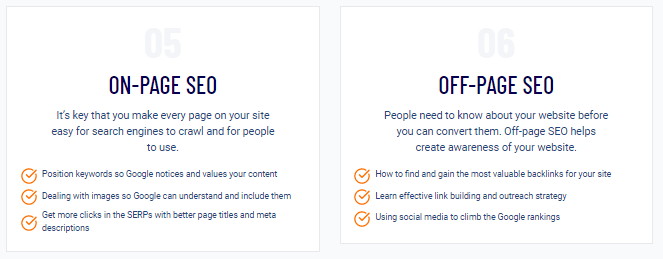Ever wonder how websites climb to the top of Google search results? It’s all thanks to something called SEO. That stands for Search Engine Optimization. But here’s the twist — it’s not just one thing. There are two sides to SEO: On-Page SEO and Off-Page SEO.
Think of it like making a delicious pizza. On-Page SEO is like choosing the best ingredients for your crust, sauce, and toppings. Off-Page SEO is like getting five stars for your pizza from food critics. Both matter!
What is On-Page SEO?
On-Page SEO is all the stuff you do on your own website to make it Google-friendly. It helps search engines understand what your page is about.
Here are some key parts of On-Page SEO:
- Title Tags – The title that appears on search engines. Make it clear and catchy.
- Meta Descriptions – Short text that gives a quick idea of your page’s content.
- Headings (H1, H2, H3…) – Break your content into sections. This helps readers and Google.
- Keywords – Use important words people are searching for. But don’t overdo it!
- Internal Links – Link to other pages on your site. It keeps people around longer.
- Image Alt Text – Describe your images with words so search engines can “see” them too.
Imagine you have a page about chocolate cake recipes. Good On-Page SEO makes sure Google knows it’s definitely about chocolate cake — not steak or salad.
What is Off-Page SEO?
This is the magic that happens outside your website. It’s about getting other websites to vouch for yours. It’s like getting thumbs up from trusted friends.
Here’s how Off-Page SEO works:
- Backlinks – Links from other websites that point to yours. The more high-quality links, the better.
- Social Media – Shares, likes, and comments can increase visibility.
- Brand Mentions – Even if there’s no link, Google notices when people mention your brand.
- Influencer Outreach – Partnering with influencers can boost traffic and authority.
So, if another food blogger links to your chocolate cake recipe, that helps! Google thinks, “Hmm, if others trust this page, maybe I should too.”
Key Differences
Let’s break down the main differences between On-Page and Off-Page SEO:
| Feature | On-Page SEO | Off-Page SEO |
|---|---|---|
| Location | On your website | Outside your website |
| Control | You have full control | Limited control |
| Main Tools | Keywords, tags, structure | Backlinks, shares, mentions |
Simple Tips to Improve Both
On-Page SEO Tips:
- Use clear headings and subheadings.
- Include keywords naturally in your text.
- Add images with helpful alt text.
- Link to other useful pages on your site.
- Make sure your page is fast and mobile-friendly.
Off-Page SEO Tips:
- Write awesome content people want to share.
- Reach out to other sites in your niche for backlinks.
- Be active on social media.
- Join online communities related to your topic.
- Ask happy customers for reviews online.
Final Thoughts
You need both On-Page and Off-Page SEO to win the SEO game. One without the other is like baking a pizza with no toppings or offering toppings with no crust!
Start by cleaning up your site with great On-Page SEO. Then, turn your focus outwards and get noticed with Off-Page tactics.
Mix them together, and you’ll have a recipe for online success!
- Australia Data Breach News: Regional Cybersecurity Updates - January 8, 2026
- Free Payroll Software: Best Tools for Small Business - January 8, 2026
- How to Fix WiiLink Error Code 107305 (Step-by-Step) - January 8, 2026
